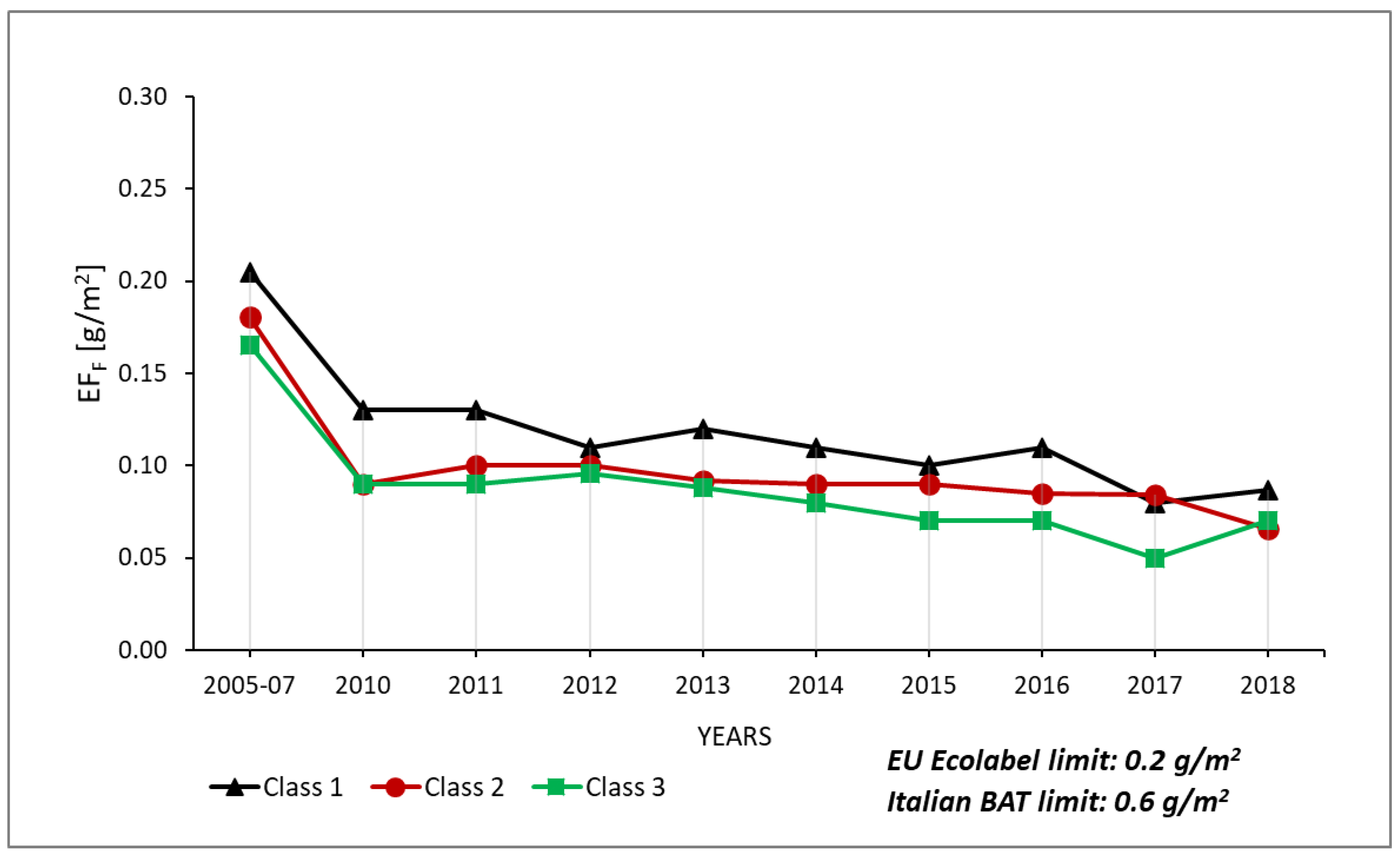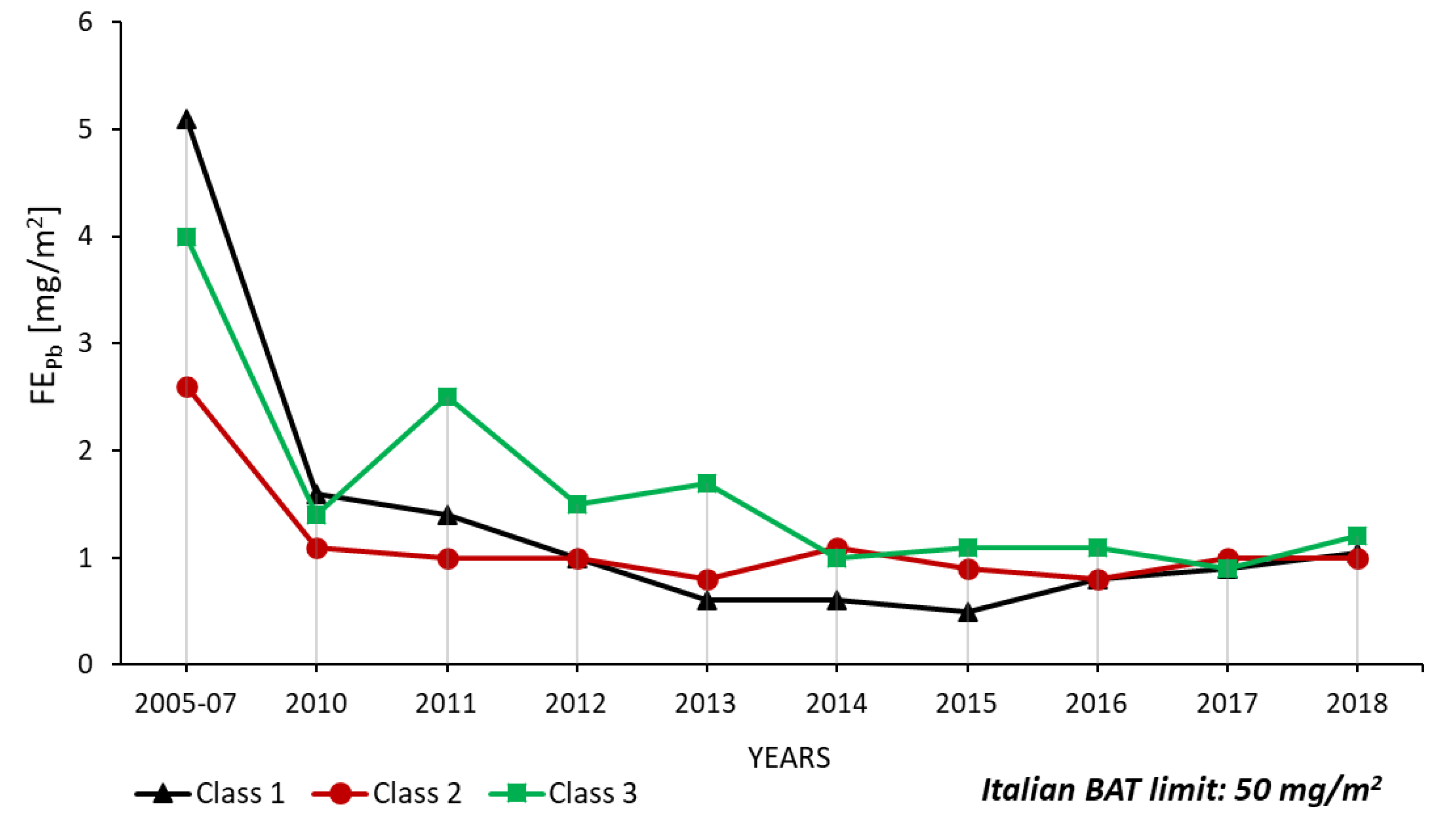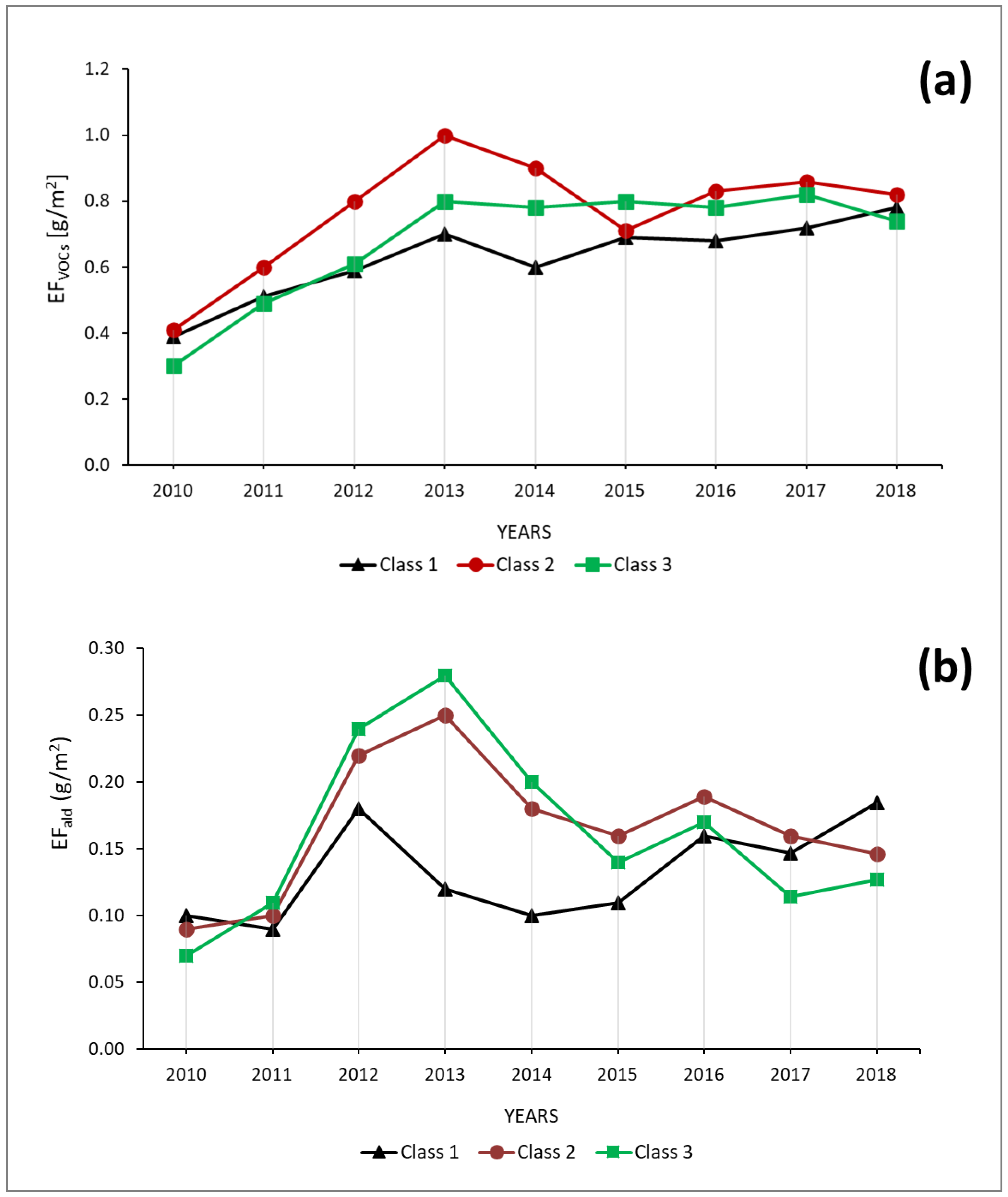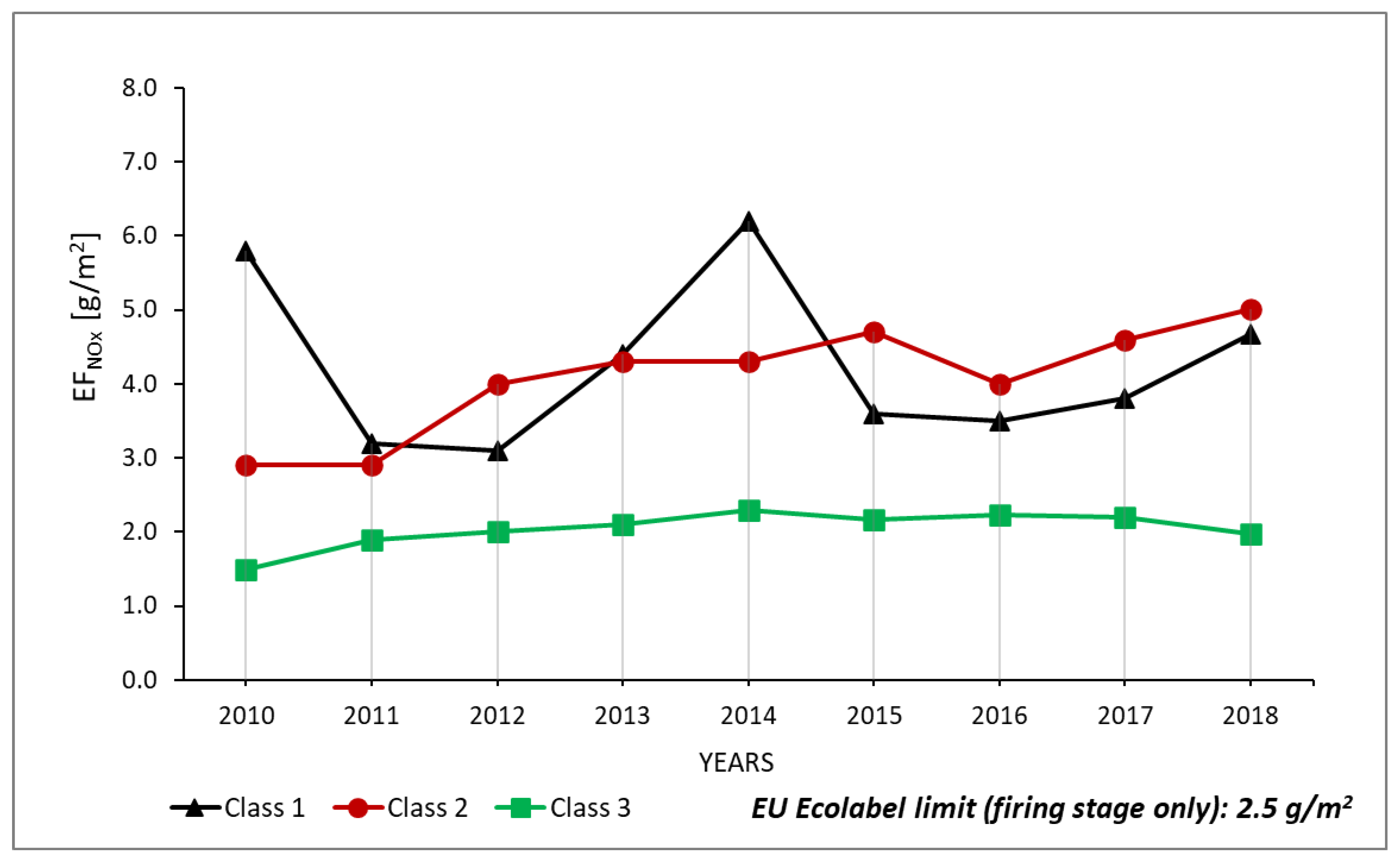Sustainability in Italian Ceramic Tile Production: Evaluation of the Environmental Impact
Abstract
:1. Introduction
2. Materials and Methods
2.1. Materials and Production Process
2.2. Environmental Indicators
- class 1: complete production cycle (as reported in Figure 2);
- class 2: complete production cycle + production of spray dried powder for other companies;
- class 3: partial production cycle involving only the steps from pressing and without considering spray-dried powders production.
- EFi [mg/m2] or [g/m2]: emission factor of the “i-th” pollutant. It indicates the amount of pollutant released per square meter of tile produced.
- Ri [%]: recycling ratio for the “i-th” material. It indicates the ratio of water or solid waste recycled within the production plant.
3. Results
3.1. Pollutants by Gaseous Emissions
3.2. Water and Waste Management
4. Conclusions
- over the last two decades, the concentration of particulate matter, fluorine and lead emitted by ceramic tile plants continuously decreased. The innovation in the production process technology have largely contributed to reach such excellent result. The concentration levels for each of the three pollutants are lower compared to the limit values reported in the Best Available Techniques (BAT) document.
- The collected data for the emission factor of volatile organic compounds (VOCs) and aldehydes cannot be compared to any limit because of the absence of such references in the Italian and European legislations. The future versions of the EU Ecolabel and ceramic BRef will probably take into account specific emission limits for these pollutants. The current situation shows that innovation in decoration is taking care to lower these types of emissions by increase the use of aqueous media.
- The trend for the emission factor of nitrogen oxides showed a modest but constant increase over the years. This is probably related to the higher thicknesses of new ceramic tiles recently presented in the market. The EU Ecolabel limit set for the emissions from firing operations has always been complied during the considered period.
- The recycling of water and solid waste are widely and successfully adopted within the Italian ceramic tiles productive sites. The virtuous values recorded for these environmental indicators demonstrate the high attention to recycling and sustainability policies performed by the ceramic industry.
Author Contributions
Funding
Acknowledgments
Conflicts of Interest
References
- Brundtland, G. Report of the World Commission on Environment and Development: Our Common Future; United Nations General Assembly Document A/42/427. Available online: https://sustainabledevelopment.un.org/milestones/wced (accessed on 14 November 2020).
- Pacheco-Torgal, F.; Cabeza, L.F.; Labrincha, J.; DeMagalhães, A. Eco-Efficient Construction and Building Materials: Life Cycle Assessment (LCA), Eco-Labelling and Case Studies; Woodhead Publishing Ltd.: Cambridge, UK, 2014; pp. 1–617. [Google Scholar]
- Azhar, S.; Carlton, W.A.; Olsen, D.; Ahmad, I. Building information modeling for sustainable design and LEED® rating analysis. Autom. Constr. 2011, 20, 217–224. [Google Scholar] [CrossRef]
- Ma, Z.; Cooper, P.; Daly, D.; Ledo, L. Existing building retrofits: Methodology and state-of-the-art. Energy Build. 2012, 55, 889–902. [Google Scholar] [CrossRef]
- Santamouris, M. Cooling the cities-A review of reflective and green roof mitigation technologies to fight heat island and improve comfort in urban environments. Sol. Energy 2014, 103, 682–703. [Google Scholar] [CrossRef]
- Mattoni, B.; Guattari, C.; Evangelisti, L.; Bisegna, F.; Gori, P.; Asdrubali, F. Critical review and methodological approach to evaluate the differences among international green building rating tools. Renew. Sust. Energy Rev. 2018, 82, 950–960. [Google Scholar] [CrossRef]
- Busani, G.; Palmonari, C.; Timellini, G. Piastrelle Ceramiche e Ambiente: Emissioni Gassose, Acque, Fanghi, Rumore; EDI.CER. SPA: Sassuolo, Italy, 1995. [Google Scholar]
- Timellini, G.; Resca, R.; Bignozzi, M.C. Ceramic Industry Air Quality. Emissions into the Atmosphere from Ceramic Tile Processes. In Comprehensive Analytical Chemistry; de la Guardia, M., Armenta, S., Eds.; Elsevier: Amsterdam, The Netherlands, 2016; Volume 73, pp. 707–729. [Google Scholar]
- Indagini Statistiche Sull’industria Italiana; Confindustria Ceramica: Sassuolo, Italy, 2019.
- World Production and Consumption of Ceramic Tiles, 7th ed.; Acimac Research Department: Baggiovara, Italy, 2019.
- Minguillón, M.C.; Querol, X.; Alastuey, A.; Monfort, E.; Mantilla, E.; Sanz, M.J.; Sanz, F.; Roig, A.; Renau, A.; Felis, C.; et al. PM10 speciation and determination of air quality target levels. A case study in a highly industrialized area of Spain. Sci. Total Environ. 2007, 372, 382–396. [Google Scholar] [CrossRef]
- Minguillón, M.C.; Monfort, E.; Querol, X.; Alastuey, A.; Celades, I.; Vicente Miró, J. Effect of ceramic industrial particulate emission control on key components of ambient PM10. J. Environ. Manag. 2009, 90, 2558–2567. [Google Scholar] [CrossRef]
- Minguillon, M.C.; Monfort, E.; Escrig, A.; Celades, I.; Guerra, L.; Busani, G.; Sterni, A.; Querol, X. Air quality comparison between two European ceramic tile clusters. Atmos. Environ. 2013, 74, 311–319. [Google Scholar] [CrossRef] [Green Version]
- Palmonari, C. Inquinamento Atmosferico da Industrie Ceramiche: Studio di un Comprensorio: Sassuolo; Centro Ceramico: Bologna, Italy, 1979. [Google Scholar]
- Piastrelle di Ceramica e Refrattari-Rapporto Integrato 1998-Ambiente, Energia, Sicurezza-Salute, Qualità; Assopiastrelle–Snam: Sassuolo, Italy, 1998.
- 2° Rapporto Integrato per il Settore delle Piastrelle di Ceramica: Ambiente, Energia, Sicurezza-Salute, Qualità, Responsabilità Sociale d’Impresa; Confindustria Ceramica: Sassuolo, Italy, 2008.
- Barbieri, C.; Sterni, A.; Torreggiani, L. Ecoscienza; Arpae Emilia-Romagna: Bologna, Italy, 2018; Volume 2, pp. 44–45. [Google Scholar]
- Best Available Techniques in the Ceramic Manufacturing Industry; European Commission: Sevilla, Spain, 2007.
- Commission Decision of 9 July 2009 establishing the ecological criteria for the award of the Community eco-label to hard coverings. Off. J. Eur. Union 2009, 208/21, 115–132.
- Il Ministro Dell’ambiente e Della Tutela Del Territorio E Del Mare. Emanazione di Linee Guida per L’individuazione e L’utilizzazione delle Migliori Tecniche Disponibili, in Materia di Fabbricazione di Vetro, Fritte Vetrose e Prodotti Ceramici, per le Attività Elencate Nell’allegato I del D. Lgs. 59. 2005. Available online: https://www.ambientediritto.it/Legislazione/INQUINAMENTO/2007/dm_29gen2007_vetro.htm (accessed on 14 November 2020).
- Manfredini, T.; Pellacani, G.; Romagnoli, M.; Pennisi, L. Porcelainized Stoneware Tile. Am. Ceram. Soc. Bull. 1995, 74, 76–79. [Google Scholar]
- Dondi, M.; Raimondo, M.; Zanelli, C. Clays and bodies for ceramic tiles: Reappraisal and technological classification. Appl. Clay Sci. 2014, 96, 91–109. [Google Scholar] [CrossRef]
- Dondi, M.; Guarini, G.; Conte, S. Deposits, composition and technological behavior of fluxes for ceramic tiles. Period. Miner. 2019, 88, 235–257. [Google Scholar] [CrossRef]
- Casasola, R.; Ma Rincón, J.; Romero, M. Glass-ceramic glazes for ceramic tiles: A review. J. Mater. Sci. 2012, 47, 553–582. [Google Scholar] [CrossRef] [Green Version]
- Pan, Z.; Wang, Y.; Huang, H.; Ling, Z.; Dai, Y.; Ke, S. Recent development on preparation of ceramic inks in ink-jet printing. Ceram. Int. 2015, 41, 12515–12528. [Google Scholar] [CrossRef]
- Güngör, G.L.; Kara, A.; Gardini, D.; Blosi, M.; Dondi, M.; Zanelli, C. Ink-jet printability of aqueous ceramic inks for digital decoration of ceramic tiles. Dye. Pigment. 2016, 127, 148–154. [Google Scholar] [CrossRef]
- Breedveld, L.; Timellini, G.; Casoni, G.; Fregni, A.; Busani, G. Eco-efficiency of fabric filters in the Italian ceramic tile industry. J. Clean Prod. 2007, 15, 86–93. [Google Scholar] [CrossRef]
- Bonvicini, G.; Fregni, A.; Palmonari, C. Fluorine Compounds from Industrial Sources: The Case of Ceramic Industries. In Fluorine and the Environment: Atmospheric Chemistry, Emissions, and Lithosphere, Volume 1; Tressaud, A., Ed.; Elsevier: Amsterdam, The Netherlands, 2006; pp. 225–249. [Google Scholar]
- Monfort, E.; Garcia-Ten, J.; Celades, I.; Gazulla, M.F.; Gomar, S. Evolution of fluorine emissions during the fast firing of ceramic tile. Appl. Clay Sci. 2008, 38, 250–258. [Google Scholar] [CrossRef]
- Shackelford, J.; Doremus, R.H. (Eds.) Ceramic and Glass Materials: Structure, Properties and Processing; Springer: New York, NY, USA, 2008. [Google Scholar]
- Jarup, L. Hazards of heavy metal contamination. Br. Med. Bull. 2003, 68, 167–182. [Google Scholar] [CrossRef] [Green Version]
- Vitali, S.; Giorgini, L. Overview of the Rheological Behaviour of Ceramic Slurries. FME Trans. 2019, 47, 42–47. [Google Scholar] [CrossRef]
- Ros-Dosda, T.; Fullana-i-Palmer, P.; Mezquita, A.; Masoni, P.; Monfort, E. How can the European ceramic tile industry meet the EU’s low-carbon targets? A life cycle perspective. J. Clean Prod. 2018, 199, 554–564. [Google Scholar] [CrossRef]
- Brusseau, M.L.; Matthias, A.D.; Comrie, A.C.; Musil, S.A. Atmospheric Pollution. In Environmental and Pollution Science, 3rd ed.; Brusseau, M.L., Pepper, I.L., Gerba, C.P., Eds.; Academic Press: Cambridge, MA, USA, 2019; pp. 293–309. [Google Scholar]
- Monfort, E.; Celades, I.; Gomar, S.; Rueda, F.; Martinez, J. Characterisation of acid pollutant emissions in ceramic tile manufacture. Bol. Soc. Esp. Ceram. Vidr. 2011, 50, 179–184. [Google Scholar] [CrossRef]
- Palmonari, C.; Timellini, G. Air pollution from the ceramic industry: Control experiences in the Italian ceramic tile industry. Am. Ceram. Soc. Bull. 1989, 68, 1464–1469. [Google Scholar]
- Directive 2010/75/EU of the European Parliament and of the Council of 24 November 2010 on Industrial Emissions (Integrated Pollution Prevention and Control), Official Journal of the European Union. 2010. Available online: https://eur-lex.europa.eu/eli/dir/2010/75/oj (accessed on 14 November 2020).
- Stationary Source Emissions-Determination of Low Range Mass Concentration of Dust-Manual Gravimetric Method; CEN: Brussels, Belgium, 2003.
- Stationary Source Emissions-Determination of Low Range Mass Concentration of Dust—Part 1: Manual Gravimetric Method; CEN: Brussels, Belgium, 2017.
- Rilevamento delle Emissioni in Flussi Gassosi Convogliati di Composti Organici del Cloro e del Fluoro Sotto Forma di Gas e Vapore Espressi Rispettivamente Come HCl e HF; Istituto Superiore di Sanità: Rome, Italy, 2000.
- Campionamento e Dosaggio di Microinquinanti in Flussi Gassosi Convogliati; Istituto Superiore di Sanità: Rome, Italy, 1988.
- Misure Alle Emissioni-Flussi Gassosi Convogliati-Solubilizzazione di Materiale Particellare per la Determinazione dei Metalli Mediante Tecniche di Spettrometria (EM/22); UNICHIM: Milano, Italy, 1986.
- Stationary Source Emissions-Determination of the Mass Concentration of Total Gaseous Organic Carbon-Continuous Flame Ionisation Detector Method; CEN: Brussels, Belgium, 2013.
- EPA TO-11A, Determination of Formaldehyde in Ambient Air Using Adsorbent Cartridge Followed by High Performance Liquid Chromatography (HPLC); Waters Corporation: Milford, MA, USA, 2008.
- Rilevamento Delle Emissioni in Flussi Gassosi Convogliati di Ossidi di Zolfo e Ossidi di Azoto Espressi Rispettivamente Come SO2 e NO2; Istituto Superiore di Sanità: Rome, Italy, 2000.
- Directive (EU) 2018/410 of the European Parliament and of the Council of 14 March 2018 Amending Directive 2003/87/EC to Enhance Cost-Effective Emission Reductions and Low-Carbon Investments, and Decision (EU) 2015/1814; European Parliament, Council of the European Union: Brussels, Belgium, 2018.
- Indicazioni Generali Sulla Semplificazione del Monitoraggio e Controllo Degli Impianti Soggetti ad Autorizzazione Integrata Ambientale (AIA) ed in Particolare Degli Impianti Ceramici; Bollettino Ufficiale della Regione Emilia-Romagna: Bologna, Italy, 2014.
- Ferrari, G.; Zannini, P. VOCs monitoring of new materials for ceramic tiles decoration: GC–MS analysis of emissions from common vehicles and inkjet inks during firing in laboratory. Bol. Soc. Esp. Cerám. Vidr. 2017, 56, 226–236. [Google Scholar] [CrossRef]
- Manfredini, T.; Marzola, G.; Nunziello, S.; Pellacani, G.; Pozzi, P.; Tubertini, O. The Recycling of Ceramic Sludges in the Production Process-An Option for Ceramic Tile Factories to Reach Zero Pollution. Environ. Technol. 1991, 12, 927–934. [Google Scholar] [CrossRef]
- Nandi, V.S.; Raupp-Pereira, F.; Montedo, O.R.K.; Oliveira, A.P.N. The use of ceramic sludge and recycled glass to obtain engobes for manufacturing ceramic tiles. J. Clean Prod. 2015, 86, 461–470. [Google Scholar] [CrossRef]
- Rambaldi, E.; Esposito, L.; Tucci, A.; Timellini, G. Recycling of polishing porcelain stoneware residues in ceramic tiles. J. Eur. Ceram. Soc. 2007, 27, 3509–3515. [Google Scholar] [CrossRef]










Publisher’s Note: MDPI stays neutral with regard to jurisdictional claims in published maps and institutional affiliations. |
© 2020 by the authors. Licensee MDPI, Basel, Switzerland. This article is an open access article distributed under the terms and conditions of the Creative Commons Attribution (CC BY) license (http://creativecommons.org/licenses/by/4.0/).
Share and Cite
Boschi, G.; Masi, G.; Bonvicini, G.; Bignozzi, M.C. Sustainability in Italian Ceramic Tile Production: Evaluation of the Environmental Impact. Appl. Sci. 2020, 10, 9063. https://doi.org/10.3390/app10249063
Boschi G, Masi G, Bonvicini G, Bignozzi MC. Sustainability in Italian Ceramic Tile Production: Evaluation of the Environmental Impact. Applied Sciences. 2020; 10(24):9063. https://doi.org/10.3390/app10249063
Chicago/Turabian StyleBoschi, Giacomo, Giulia Masi, Giuliana Bonvicini, and Maria Chiara Bignozzi. 2020. "Sustainability in Italian Ceramic Tile Production: Evaluation of the Environmental Impact" Applied Sciences 10, no. 24: 9063. https://doi.org/10.3390/app10249063





